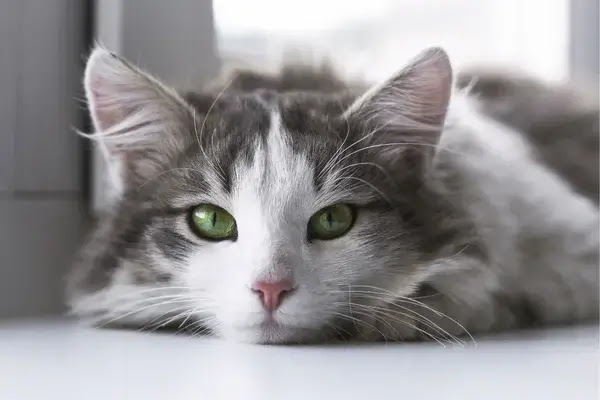If you have ever encountered a stubborn cat, you know that it can be a handful to deal with. Stubbornness in cats can manifest in various ways, from refusing to follow commands to resisting attempts to change their behavior. Describing a stubborn cat requires an understanding of its temperament, behavior patterns, and the underlying reasons behind its defiance. In this topic, we will explore what makes a cat stubborn, how to recognize their behavior, and some tips for handling them.
How do you describe a stubborn cat?
- A stubborn cat is one that is determined to have its way and refuses to listen to its owner’s commands.
- They often display a strong-willed personality and can be quite challenging to train.
- Stubborn cats may exhibit behaviors such as scratching furniture, ignoring litter box training, or resisting attempts to groom them.
- They may also be resistant to new people or changes in their environment.
- Despite their stubbornness, they can still be affectionate and loving towards their owners.
- These cats may require a patient and consistent approach to training and may benefit from positive reinforcement techniques.
- It is important to establish boundaries and rules early on to prevent the cat from developing bad habits.
- Consistency and patience are key when dealing with stubborn cats, as they may take longer to learn and adapt to new routines.
- Providing plenty of mental and physical stimulation through toys and playtime can help to channel their energy and reduce undesirable behaviors.
Overall, a stubborn cat can be a challenge but with the right approach and care, they can still make wonderful pets.
What are some common behaviors exhibited by stubborn cats, and how can their owners effectively address these behaviors?
Stubbornness is a common trait exhibited by cats, and it can lead to challenging behaviors that owners may struggle to manage. Here are some of the common behaviors exhibited by stubborn cats, along with tips for addressing them effectively:
- Refusal to Use the Litter Box: Some cats may be stubborn about using the litter box and may instead eliminate it on the floor or in other inappropriate locations. This could be due to medical issues, litter box preferences, or environmental stressors. To address this behavior, owners should first take the cat to the vet to rule out any underlying medical conditions. Then, they should try different types of litter boxes, litter, and placement to see if the cat responds better to a different setup. Finally, owners can use positive reinforcement training to encourage the cat to use the litter box by rewarding them with treats or praise when they use it correctly.
- Scratching Furniture: Cats may be stubborn about using scratching posts or pads and may instead scratch furniture, carpets, or curtains. To address this behavior, owners can provide a variety of scratching surfaces to find out what their cat prefers. They can also use deterrent sprays or double-sided tape on furniture to discourage the cat from scratching. Finally, owners can use positive reinforcement training to reward the cat when they use appropriate scratching surfaces.
- Begging for Food: Some cats may be stubborn about begging for food, even when they have already been fed. To address this behavior, owners can establish a feeding schedule and stick to it. They should also avoid giving the cat table scraps or human food, as this can reinforce the behavior. Finally, owners can use positive reinforcement training to reward the cat when they do not beg for food.
- Hiding or Avoiding Interaction: Some cats may be stubborn about interacting with their owners, either by hiding or avoiding contact. This could be due to fear, anxiety, or past trauma. To address this behavior, owners should provide a quiet, safe space for the cat to retreat to when they feel overwhelmed. They should also try to approach the cat slowly and calmly, using treats or toys to build positive associations with interaction. Finally, owners can use a pheromone diffuser or other calming aids to reduce anxiety and stress.
In general, addressing stubborn cat behaviors requires patience, consistency, and a willingness to try different strategies. By understanding their cat’s behavior and needs, owners can find solutions that work for both themselves and their furry friends.
How do cats develop stubbornness, and are some breeds more prone to this trait than others?
The development of stubbornness in cats can be influenced by various factors, including genetics, early socialization experiences, and environmental factors. Some cats may be naturally more independent and strong-willed, while others may become stubborn as a result of a lack of socialization or negative experiences.
Regardless of breed, it is crucial to remember that all cats are unique individuals who can display a variety of personalities and habits. While some breeds may be known for certain traits, such as Siamese cats being vocal or Maine Coons being more dog-like, there is no specific breed that is more prone to stubbornness than others.
In general, a cat’s behavior is more likely to be influenced by their individual experiences, such as the quality of their socialization and training, rather than their breed. Therefore, it is important for cat owners to provide a positive and stimulating environment for their feline friends, regardless of their breed, to help them develop good behaviors and avoid the development of negative ones, such as stubbornness.
What are some strategies for training a stubborn cat, and how long does it typically take to see results?
Training a stubborn cat can be challenging, but with patience and consistency, it is possible to achieve positive results. Here are some strategies for training a stubborn cat:
- Use Positive Reinforcement: Cats respond well to positive reinforcement, so reward your cat with treats, praise, or toys when they exhibit desirable behaviors.
- Be Consistent: Consistency is key when training a cat. Use the same commands and rewards every time, and make sure everyone in the household is on the same page.
- Keep Training Sessions Short: Cats have short attention spans, so keep training sessions short and frequent. Five to ten minutes a day is usually enough.
- Use Clicker Training: Clicker training can be an effective way to train a cat. Use a clicker to mark desirable behaviors, and then reward your cat immediately.
- Address Undesirable Behaviors: Instead of punishing your cat for undesirable behaviors, try to redirect their attention to more appropriate behavior. For example, if your cat is scratching the furniture, redirect them to a scratching post.
- Provide a Stimulating Environment: A stimulating environment can help keep a cat’s attention and prevent boredom, which can lead to undesirable behaviors. Provide plenty of toys, scratching posts, and interactive playtime.
The amount of time it takes to see results can vary depending on the cat’s age, temperament, and behavior being trained. Some cats may respond quickly to training, while others may take longer to show progress. It is important to be patient and consistent and to celebrate small successes along the way. If you are struggling to train your cat, consider consulting with a professional cat trainer or behaviorist for additional guidance.
Can a cat’s stubbornness be indicative of underlying health or behavioral issues, and if so, how should an owner approach addressing these issues?
A cat’s stubbornness can sometimes be indicative of underlying health or behavioral issues. For example, a cat that is not using the litter box may be exhibiting this behavior due to a urinary tract infection or other medical condition, rather than stubbornness. Similarly, a cat that is avoiding interaction may be doing so due to fear or anxiety.
If an owner suspects that their cat’s stubbornness is due to an underlying health or behavioral issue, they should take the cat to the vet for a thorough examination. The vet can rule out any medical conditions that may be causing the behavior and provide treatment if necessary. In the case of behavioral issues, the vet may refer the owner to a professional cat trainer or behaviorist for additional guidance.
In addition to seeking professional help, owners can also take steps to provide a positive and stimulating environment for their cats, which can help address some behavioral issues. This can include providing plenty of toys and scratching posts, establishing a regular feeding and playtime schedule, and using positive reinforcement training to encourage good behaviors.
It is important for owners to approach addressing these issues with patience, consistency, and a willingness to try different strategies. By understanding their cat’s behavior and needs, owners can work to address underlying issues and develop a positive relationship with their furry friend.
How can an owner maintain a positive relationship with a stubborn cat, while still setting boundaries and maintaining discipline?
Maintaining a positive relationship with a stubborn cat while also setting boundaries and maintaining discipline can be challenging, but it is possible with the right approach. Here are some tips to help:
- Use Positive Reinforcement: Reward good behavior with treats, praise, or playtime to encourage your cat to continue exhibiting positive behaviors.
- Avoid Punishment: Avoid punishing your cat for undesirable behavior, as this can create fear and anxiety, and may worsen the behavior over time. Instead, try to redirect their attention to more appropriate behavior.
- Establish Clear Rules and Boundaries: Cats thrive on routine and predictability, so establish clear rules and boundaries for your cat, and be consistent in enforcing them.
- Use Gentle Correction: If your cat is exhibiting undesirable behavior, use gentle correction, such as a firm “no” or clap of the hands, to interrupt the behavior and redirect their attention.
- Provide Adequate Attention and Playtime: Cats require attention and playtime to stay mentally and physically stimulated. Make sure you are providing enough attention and playtime to prevent boredom and undesirable behaviors.
- Create a Safe and Comfortable Environment: Make sure your cat has a comfortable and safe environment that meets its physical and emotional needs. This includes providing enough food and water, comfortable sleeping areas, and a safe place to play and explore.
Remember, every cat is different, so it may take time to find the right balance of positive reinforcement, discipline, and attention that works for your cat. With patience, consistency, and a willingness to adapt, you can maintain a positive relationship with your stubborn cat while also setting boundaries and maintaining discipline.
Are there any particular toys, treats, or activities that can help to engage a stubborn cat and encourage positive behavior?
- Puzzle Feeders: Puzzle feeders are interactive toys that challenge your cat to work for their food. They can help keep your cat mentally stimulated and engaged.
- Wand Toys: Wand toys are great for interactive playtime and can help strengthen the bond between you and your cat. Choose a wand toy that matches your cat’s play style, such as feathers or a toy mouse.
- Scratching Posts: Scratching posts provide a great outlet for your cat’s natural scratching behavior and can help prevent furniture damage. Try different textures and sizes to find the one your cat prefers.
- Catnip Toys: Catnip toys can provide a fun and stimulating activity for your cat. Look for toys that are made with high-quality catnip and are safe for your cat to play with.
- Clicker Training: Clicker training can be a great way to engage your cat and encourage positive behavior. Use a clicker to mark desirable behaviors, and then reward your cat immediately.
- Treat-Dispensing Toys: Treat-dispensing toys are another great way to keep your cat mentally stimulated and engaged. They challenge your cat to work for their treats, which can help prevent boredom and encourage positive behavior.
How can an owner recognize the difference between stubbornness and aggression in their cat, and what steps should be taken to address each behavior?
Stubbornness:
- A stubborn cat may refuse to follow commands or engage in certain activities, but they typically do not exhibit aggressive behavior.
- They may show signs of frustration, such as hissing or growling, but these behaviors are usually defensive and not intended to harm.
Aggression:
- An aggressive cat may exhibit threatening behaviors, such as growling, hissing, or spitting.
- They may attack people or other animals without provocation, and their behavior can be dangerous.
- Consult with a Vet: Rule out any medical conditions that may be causing the behavior, such as pain or illness.
- Seek Professional Help: Consult with a professional cat trainer or behaviorist who can provide guidance on how to manage aggressive behavior.
- Safety Measures: Take steps to ensure your safety and the safety of others. This may include keeping the cat separated from other pets or family members until the behavior is under control.
- Behavior Modification: Work with a professional trainer to develop a behavior modification plan that addresses the root cause of the aggression and helps the cat learn new, more appropriate behaviors.
- Use Positive Reinforcement: Reward good behavior with treats, praise, or playtime to encourage your cat to continue exhibiting positive behaviors.
- Avoid Punishment: Avoid punishing your cat for undesirable behavior, as this can create fear and anxiety, and may worsen the behavior over time.
- Establish Clear Rules and Boundaries: Establish clear rules and boundaries for your cat, and be consistent in enforcing them.
- Provide Adequate Attention and Playtime: Provide enough attention and playtime to prevent boredom and undesirable behaviors.
- Create a Safe and Comfortable Environment: Make sure your cat has a comfortable and safe environment that meets its physical and emotional needs.
Are there any particular training or socialization techniques that are particularly effective in addressing stubbornness in cats?
- Positive Reinforcement Training: Positive reinforcement training involves rewarding desirable behavior with treats, praise, or playtime, and can be very effective in shaping a cat’s behavior. When your cat exhibits desirable behavior, reward them with a treat or praise to reinforce the behavior.
- Clicker Training: Clicker training is a type of positive reinforcement training that uses a clicker to mark desirable behavior, followed by a reward. The clicker acts as a signal to the cat that they have done something right, and the reward reinforces the behavior.
- Counter-Conditioning: Counter-conditioning involves replacing an undesirable behavior with a desirable one. For example, if your cat scratches the furniture, provide them with a scratching post as an alternative and reward them for using it.
- Socialization: Socialization involves exposing your cat to new experiences, people, and animals to help them develop positive associations and reduce fear and anxiety. Gradual exposure to new experiences can help your cat become more comfortable and less stubborn.
- Exercise and Playtime: Providing your cat with enough exercise and playtime can help prevent boredom and undesirable behaviors. Use interactive toys or play with your cat to keep them engaged and stimulated.
- Environmental Enrichment: Environmental enrichment involves providing your cat with a stimulating environment that meets its physical and emotional needs. This can include things like scratching posts, climbing structures, and toys to play with.
Can stubbornness in cats be inherited or passed down through generations, and if so, what are the implications for breeding programs?
How can an owner ensure that their stubborn cat receives adequate exercise, mental stimulation, and socialization, despite their reluctance to participate in certain activities?
- Offer a variety of toys and activities: Cats can be very picky about the types of toys and activities they enjoy. Try offering a variety of options, including puzzle feeders, interactive toys, and scratching posts to find out what your cat likes best.
- Incorporate exercise into everyday activities: You can encourage your cat to exercise by incorporating it into everyday activities. For example, playing games like “chase the laser pointer” or “hide and seek” can be fun for your cat and provide exercise at the same time.
- Provide a stimulating environment: Make sure your cat has access to plenty of hiding places, scratching posts, and climbing structures. Consider adding shelves or perches near windows so your cat can watch birds and other wildlife outside.
- Use positive reinforcement: When your cat engages in activities like playing or exploring, reward them with treats, praise, or extra playtime. This can help to reinforce positive behaviors and encourage your cat to participate in activities they might otherwise avoid.
- Consider socialization: If your cat is hesitant around new people or animals, consider gradually exposing them to new experiences in a controlled and positive way. Start with short, supervised visits and gradually increase the duration and complexity of the interactions.




